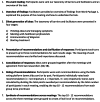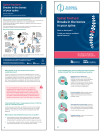Improving patients' experiences of diagnosis and treatment of vertebral fracture: co-production of knowledge sharing resources
- PMID: 38383386
- PMCID: PMC10880218
- DOI: 10.1186/s12891-024-07281-9
Improving patients' experiences of diagnosis and treatment of vertebral fracture: co-production of knowledge sharing resources
Abstract
Background: Osteoporosis involves changes to bones that makes them prone to fracture. The most common osteoporotic fracture is vertebral, in which one or more spinal vertebrae collapse. People with vertebral fracture are at high risk of further fractures, however around two-thirds remain undiagnosed. The National Institute for Health and Care Excellence (NICE) recommends bone protection therapies to reduce this risk. This study aimed to co-produce a range of knowledge sharing resources, for healthcare professionals in primary care and patients, to improve access to timely diagnosis and treatment.
Methods: This study comprised three stages: 1. In-depth interviews with primary care healthcare professionals (n = 21) and patients with vertebral fractures (n = 24) to identify barriers and facilitators to diagnosis and treatment. 2. A taxonomy of barriers and facilitators to diagnosis were presented to three stakeholder groups (n = 18), who suggested ways of identifying, diagnosing and treating vertebral fractures. Fourteen recommendations were identified using the nominal group technique. 3. Two workshops were held with stakeholders to co-produce and refine the prototype knowledge sharing resources (n = 12).
Results: Stage 1: Factors included lack of patient information about symptoms and risk factors, prioritisation of other conditions and use of self-management. Healthcare professionals felt vertebral fractures were harder to identify in lower risk groups and mistook them for other conditions. Difficulties in communication between primary and secondary care meant that patients were not always informed of their diagnosis, or did not start treatment promptly. Stage 2: 14 recommendations to improve management of vertebral fractures were identified, including for primary care healthcare professionals (n = 9) and patients (n = 5). Stage 3: The need for allied health professionals in primary care to be informed about vertebral fractures was highlighted, along with ensuring that resources appealed to under-represented groups. Prototype resources were developed. Changes included help-seeking guidance and clear explanations of medical language.
Conclusions: The study used robust qualitative methods to co-produce knowledge sharing resources to improve diagnosis. A co-production approach enabled a focus on areas stakeholders thought to be beneficial to timely and accurate diagnosis and treatment. Dissemination of these resources to a range of stakeholders provides potential for substantial reach and spread.
Keywords: Co-production; Osteoporosis; Qualitative; Vertebral fractures.
© 2024. The Author(s).
Conflict of interest statement
ZP has undertaken both unpaid and paid, non-promotional consultancy for UCB Pharma. ZP is funded by the National Institute for Health and care Research (NIHR), Clinician Scientist Award (CS-2018-18-ST2-010)/NIHR Academy. SB, RGH, EC, NW and SD declare no competing interests. The views expressed are those of the authors and not necessarily those of the NIHR, NHS or Department for Health and Social Care.
Figures
Similar articles
-
Recognizing and reporting vertebral fractures: reducing the risk of future osteoporotic fractures.Can Assoc Radiol J. 2007 Feb;58(1):27-36. Can Assoc Radiol J. 2007. PMID: 17408160
-
Diagnosis and Treatment of Osteoporosis Before and After Fracture: A Side-by-Side Analysis of Commercially Insured and Medicare Advantage Osteoporosis Patients.J Manag Care Spec Pharm. 2017 Jul;23(7):735-744. doi: 10.18553/jmcp.2017.23.7.735. J Manag Care Spec Pharm. 2017. PMID: 28650253 Free PMC article.
-
Management of Osteoporosis and Spinal Fractures: Contemporary Guidelines and Evolving Paradigms.Clin Med Res. 2022 Jun;20(2):95-106. doi: 10.3121/cmr.2021.1612. Epub 2022 Apr 27. Clin Med Res. 2022. PMID: 35478096 Free PMC article. Review.
-
Men's experiences of having osteoporosis vertebral fractures: a qualitative study using interpretative phenomenological analyses.Osteoporos Int. 2019 Jul;30(7):1403-1412. doi: 10.1007/s00198-019-04973-0. Epub 2019 Apr 30. Osteoporos Int. 2019. PMID: 31041474
-
EMAS position statement: The management of postmenopausal women with vertebral osteoporotic fracture.Maturitas. 2014 Jun;78(2):131-7. doi: 10.1016/j.maturitas.2014.03.002. Epub 2014 Mar 7. Maturitas. 2014. PMID: 24679890 Review.
Cited by
-
Fixation Failure in Osteoporotic Bone: A Review of Complications and Outcomes.Indian J Orthop. 2024 Dec 21;59(3):389-404. doi: 10.1007/s43465-024-01316-y. eCollection 2025 Mar. Indian J Orthop. 2024. PMID: 40201917 Review.
-
How do patient information documents present dialysis and conservative kidney management? A document analysis.Clin Kidney J. 2025 May 12;18(6):sfaf136. doi: 10.1093/ckj/sfaf136. eCollection 2025 Jun. Clin Kidney J. 2025. PMID: 40487369 Free PMC article.
References
-
- O’Neill TW, Felsenberg D, Varlow J, Cooper C, Kanis JA, Silman AJ. The prevalence of vertebral deformity in European men and women: the European vertebral osteoporosis study. J Bone Min Res. 1996;11(7):1010–8. - PubMed
-
- Hip fracture. Management. Clinical guideline [CG124]. National Institute for Health and Care Excellence; 2011. - PubMed
-
- Low back pain and. Sciatica in over 16s Quality standard [QS155]. National Institute of Health Research; 2017.
-
- Clark EM, Gould V, Morrison L, Ades AE, Dieppe P, Tobias JH. Randomized controlled trial of a primary care-based screening program to identify older women with prevalent osteoporotic vertebral fractures: Cohort for Skeletal Health in Bristol and Avon (COSHIBA) J Bone Min Res. 2012;27(3):664–71. - PMC - PubMed
-
- Adams J, Clark E, Clunie G. Clinical guidance for the effective identification of vertebral fractures. Bath, UK: National Osteoporosis Society; 2017.
MeSH terms
Grants and funding
LinkOut - more resources
Full Text Sources
Medical





